|
Saturday mornings will
never be the same again…

 Cash machines
are so much a part of our lives today that it is hard to imagine life
without them, or even remember what it was like before them. Now, we face the very real prospect of
the extinction of cash itself, and the notion of a cash machine will soon
be consigned to the history books.
By the Summer of 1969, British Banks were under pressure to close on
Saturdays, and necessity became once more the mother of invention. Scotsman James Goodfellow patented the
World’s first system for using a card with a PIN Number in 1965, and the
cash machine was developed by the CHUBB Safe and Lock Company. It is this machine and James Goodfellow’s
system that Martins was first to use in the North of England in 1967. The BARCLAYCASH machine
can be rightly said to be the first of its kind - it is no secret that Barclays operated the first cash dispenser
not only in the UK, but also in the World, just four months before Martins
launched its own machine. In fairness, it must be noted that BARCLAYCASH, which was phased out by 1980 was not the kind of cash machine
we know today. A special cheque,
perforated with a code of dots needed to be read by the machine and
compared to a personal code number (PCN) which consisted of three pairs of
digits, unlike the PIN used from the start by Martins, and, of course, by
all of us in the twenty-first century.
BARCLAYBANK, launched in 1975 was the
first real attempt to provide other services as well as the withdrawal of
cash. In
the Autumn of 1967, Martins Bank was not actually sure that a Cash
Dispenser would be likely to catch on. Nevertheless, at great expense, is
went ahead and purchased one which was fitted into the wall of Liverpool
Church Street Branch, and turned out to be one of only three that the Bank
was be able to install before the merger with Barclays. In this
feature we examine both Martins Auto Cashier and the BARCLAYCASH Machine, each of which we believe should rank as EQUAL in terms of World Firsts… Cash machines
are so much a part of our lives today that it is hard to imagine life
without them, or even remember what it was like before them. Now, we face the very real prospect of
the extinction of cash itself, and the notion of a cash machine will soon
be consigned to the history books.
By the Summer of 1969, British Banks were under pressure to close on
Saturdays, and necessity became once more the mother of invention. Scotsman James Goodfellow patented the
World’s first system for using a card with a PIN Number in 1965, and the
cash machine was developed by the CHUBB Safe and Lock Company. It is this machine and James Goodfellow’s
system that Martins was first to use in the North of England in 1967. The BARCLAYCASH machine
can be rightly said to be the first of its kind - it is no secret that Barclays operated the first cash dispenser
not only in the UK, but also in the World, just four months before Martins
launched its own machine. In fairness, it must be noted that BARCLAYCASH, which was phased out by 1980 was not the kind of cash machine
we know today. A special cheque,
perforated with a code of dots needed to be read by the machine and
compared to a personal code number (PCN) which consisted of three pairs of
digits, unlike the PIN used from the start by Martins, and, of course, by
all of us in the twenty-first century.
BARCLAYBANK, launched in 1975 was the
first real attempt to provide other services as well as the withdrawal of
cash. In
the Autumn of 1967, Martins Bank was not actually sure that a Cash
Dispenser would be likely to catch on. Nevertheless, at great expense, is
went ahead and purchased one which was fitted into the wall of Liverpool
Church Street Branch, and turned out to be one of only three that the Bank
was be able to install before the merger with Barclays. In this
feature we examine both Martins Auto Cashier and the BARCLAYCASH Machine, each of which we believe should rank as EQUAL in terms of World Firsts…
|
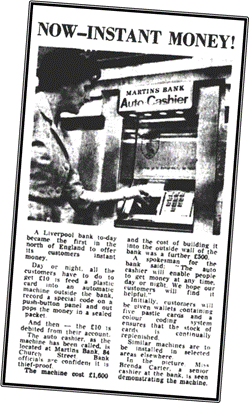
Image © Trinity
Mirror Image created courtesy of THE BRITISH LIBRARY BOARD. Image
reproduced with kind permission of The British Newspaper Archive
|
|


1967 – FROM HUMBLE PROTOTYPE….
THE MD1 Cash Dispenser
Image – Martins Bank
Archive
Ref MBM-Wi67P12
|

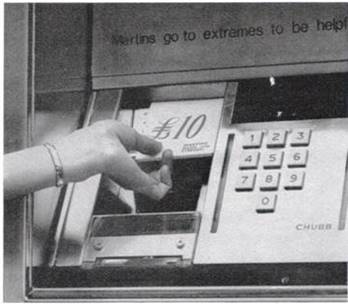

Could
this crude arrangement really be
the future of cash on demand? Well,
yes it actually was - we must remember that £10 went a long way in 1967,
and being able to obtain ten one-pound notes through the wall of the bank
whilst still a novelty, is a serious first step towards the convenience we
all take for granted in the twenty-first century! Now you can see this exact model in
action in Sydney Australia in 1969, thanks to a TV report preserved by ABC NEWS.
|

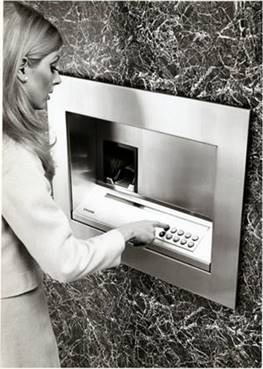
…1969 – TO BAUHAUS AWARD WINNER!
Image
© University of Brighton
-
Design Archives
Ref
GB-1837-DES-DCA-30-7-1969-1-1
|
|

  The Martins Bank Auto Cashier is the first cash
dispenser to use a plastic card in conjunction with a PIN. To
produce its BARCLAYCASH machine, Barclays goes for a
design by De La Rue, a well established company whose products are the
watchword for security. Martins Bank Auto Cashier is made by CHUBB, also
famous for security products, and from the prototype onwards, the design is
sleek, easy to use, and extremely good looking. So much so in fact, that
the designer, Jack Howe, wins the prestigious Prince Philip Design Award
for 1969. Is this a case of style over substance? Not at all, Jack Howe’s design is popular
even before his award, and its practicality and simplicity means
there are already around four hundred CHUBB machines in service around the
country, when he receives it. The following report from the Design Council,
sums up this achievement, and you see will more of the original
Martins Bank CHUBB design, a little later in this feature… The Martins Bank Auto Cashier is the first cash
dispenser to use a plastic card in conjunction with a PIN. To
produce its BARCLAYCASH machine, Barclays goes for a
design by De La Rue, a well established company whose products are the
watchword for security. Martins Bank Auto Cashier is made by CHUBB, also
famous for security products, and from the prototype onwards, the design is
sleek, easy to use, and extremely good looking. So much so in fact, that
the designer, Jack Howe, wins the prestigious Prince Philip Design Award
for 1969. Is this a case of style over substance? Not at all, Jack Howe’s design is popular
even before his award, and its practicality and simplicity means
there are already around four hundred CHUBB machines in service around the
country, when he receives it. The following report from the Design Council,
sums up this achievement, and you see will more of the original
Martins Bank CHUBB design, a little later in this feature…

The
Design Council – Prince Philip 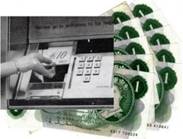 Award
for 1969 was awarded to Jack Howe for his design – The MD2 cash dispenser for Chubb
Ltd. Chubb narrowly
lost out to De La Rue in the race to launch the UK’s (and the World’s)
first cash dispenser in 1967, but their
version’s steel-clad good looks and simple controls were enough to ensure
that 400 were operating nationwide by the time Howe received his award. The
one-time employee of Bauhaus founder Walter Gropius was praised for ‘an
elegant solution to the problem of security for banks’. Customers used a
card and PIN — also new technology, developed in the UK in 1965 — to
withdraw a plastic pack containing ten £1 notes. The machine kept the card,
which the bank posted back after debiting the customer’s account. Award
for 1969 was awarded to Jack Howe for his design – The MD2 cash dispenser for Chubb
Ltd. Chubb narrowly
lost out to De La Rue in the race to launch the UK’s (and the World’s)
first cash dispenser in 1967, but their
version’s steel-clad good looks and simple controls were enough to ensure
that 400 were operating nationwide by the time Howe received his award. The
one-time employee of Bauhaus founder Walter Gropius was praised for ‘an
elegant solution to the problem of security for banks’. Customers used a
card and PIN — also new technology, developed in the UK in 1965 — to
withdraw a plastic pack containing ten £1 notes. The machine kept the card,
which the bank posted back after debiting the customer’s account.

The Chubb MD2 Cash Dispenser
Image © University of Brighton Design
Archives
Ref GB-1837-DES-DCA-30-7-1969-1-2

Now,
Martins Bank Magazine reflects - somewhat wryly - upon its latest
investment, and seems almost bemused by the possible uses of a cash
dispenser. This is apparent from the
various stereotypes used by the magazine as it tries to predict just who
might use the machine, and why… ( To read the Bank’s Press Release
for Martins Auto Cashier, click HERE )

 

local rather than
national publicity was an introductory feature of the Bank's first cash
dispenser, brought into use on 31 October at Church Street branch,
Liverpool.
This is, of course, the first dispenser in the
North and others will follow shortly but it is essentially an experiment—simple to operate, attractive, apparently thief-proof and is
possibly the forerunner of even bigger innovations. It is this last aspect
which the staff will find intriguing. The machine provides
ten £1 notes for each
plastic card inserted by the customer who keys a number known only to
himself or herself—not necessarily a Church Street customer but any
customer who thinks he may have a sudden need for ready cash while in the
Liverpool shopping and entertainment centre.
 The first point to be remembered is that for its comparatively
limited capacity the machine is costly. But what price bigger and better
dispensers in large centres or in the shopping precincts ? Would the housewives
use them before doing their Saturday shopping? Could built-in dispensers
become one of the features of the populous areas in big cities and at
airports and railway termini? To be
an economic proposition the dispenser of the future will, ideally, not only
supply a variety of cash round the clock but take the place of one or more
cashiers. It could then reduce the counter queues in banks, and perhaps
pre-debiting as for travellers' cheques could reduce book-keeping, for if
it were to bring additional and complicated records it would defeat much of
its purpose. What intrigues us just now is whether the customers will show
they want it. Will they provide us with proof that the chequeless or
cashless society is not just a dream ? Many
people may think there is an element of danger in collecting one’s cash in
the street, but how dangerous has the use of the night safe proved to be
when, like a dispenser, available round the clock? In a prominent site like Church Street it will be
interesting to see whether every cosh-bearing Merseyside yob takes to standing all innocent-like on the pavement hoping
to pull off a snatch in multiples of £10. More probably he will prefer the big
money grabs between 10 and 3 which at least he can plan and thereby avoid
standing about in the cold. Maybe we will not
learn a lot about this new dispenser for some months. It may catch on
quickly or it may not appeal. That some other banks have also taken up the
idea is an indication that no matter how much one may hope for a cashless
society this may be a long time coming, and meanwhile the late-night taxi
driver will insist on something more than the sight of a credit card.
Various manufacturers, we understand, are already interested in further
developments and when one thinks of all the things obtainable today from
slot machines and dispensers it is surprising that only in England in 1967
have some of the banks come out with machines which can produce what
everybody wants, all the time, more than anything else — money! The first point to be remembered is that for its comparatively
limited capacity the machine is costly. But what price bigger and better
dispensers in large centres or in the shopping precincts ? Would the housewives
use them before doing their Saturday shopping? Could built-in dispensers
become one of the features of the populous areas in big cities and at
airports and railway termini? To be
an economic proposition the dispenser of the future will, ideally, not only
supply a variety of cash round the clock but take the place of one or more
cashiers. It could then reduce the counter queues in banks, and perhaps
pre-debiting as for travellers' cheques could reduce book-keeping, for if
it were to bring additional and complicated records it would defeat much of
its purpose. What intrigues us just now is whether the customers will show
they want it. Will they provide us with proof that the chequeless or
cashless society is not just a dream ? Many
people may think there is an element of danger in collecting one’s cash in
the street, but how dangerous has the use of the night safe proved to be
when, like a dispenser, available round the clock? In a prominent site like Church Street it will be
interesting to see whether every cosh-bearing Merseyside yob takes to standing all innocent-like on the pavement hoping
to pull off a snatch in multiples of £10. More probably he will prefer the big
money grabs between 10 and 3 which at least he can plan and thereby avoid
standing about in the cold. Maybe we will not
learn a lot about this new dispenser for some months. It may catch on
quickly or it may not appeal. That some other banks have also taken up the
idea is an indication that no matter how much one may hope for a cashless
society this may be a long time coming, and meanwhile the late-night taxi
driver will insist on something more than the sight of a credit card.
Various manufacturers, we understand, are already interested in further
developments and when one thinks of all the things obtainable today from
slot machines and dispensers it is surprising that only in England in 1967
have some of the banks come out with machines which can produce what
everybody wants, all the time, more than anything else — money!

|
|
 Announcing: BARCLAYCASH… Announcing: BARCLAYCASH…

Alright, credit where credit’s due and all that,
but so what if Barclays does
get there first, by unveiling the world’s first cash dispenser at the end
of June 1967? At least Martins,
being only four months behind, is the first bank to unveil a cash machine
in the North of England, AND the first to use the concept of card
and PIN that we all know today – That is still a major achievement…
 
|
|

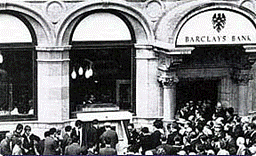 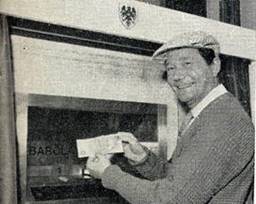
|
< Left: the crowds gather in amazement in Enfield to see TV Star
and Comedian Reg Varney become the first ATM customer in the world. (Pictures © de la Rue Ltd and Barclays)



Right: The new service is advertised in the press. This somewhat minimalist ad tells us all
we need to know – that from now on , our cash will forever be at our
fingertips…>
|

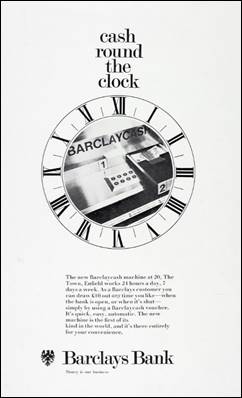
|
|

|
|
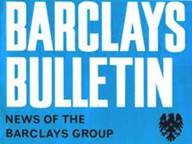  BARCLAYS Bank Limited,
which recently ordered 75 automatic cash dispensing machines from De La Rue
Instruments Limited for its Barclaycash Service, has increased the order to
250 machines. Delivery of these 'robot cashiers' started last month and it
is planned to have the majority installed and in operation by the end of
June next year. These machines, which enable customers to withdraw cash
from their accounts 24 hours a day, 7 days a week, will be sited to cover
areas with the largest population and the greatest number of accounts,
giving the best possible geographic coverage', said Mr. D. M. Taylor, a
General Manager of Barclays Bank. BARCLAYS Bank Limited,
which recently ordered 75 automatic cash dispensing machines from De La Rue
Instruments Limited for its Barclaycash Service, has increased the order to
250 machines. Delivery of these 'robot cashiers' started last month and it
is planned to have the majority installed and in operation by the end of
June next year. These machines, which enable customers to withdraw cash
from their accounts 24 hours a day, 7 days a week, will be sited to cover
areas with the largest population and the greatest number of accounts,
giving the best possible geographic coverage', said Mr. D. M. Taylor, a
General Manager of Barclays Bank.

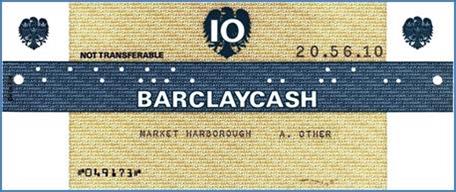 'We are spending
over £1 million on the installation
of these machines in an effort to provide a compensatory service for the
Saturday closure of branches, due to come into operation on July 1 next
year. 'Every customer within the Greater
London area, and over half of those outside London, will have one of these
machines within three miles of their usual banking branch. For the remaining customers the nearest
machine will be only a short car journey away.' The Barclaycash Service,
developed by the Bank's Management Services Department in conjunction with
De La Rue Instruments, is designed to dispense £10 against a special voucher which can be processed in the
same way as an ordinary cheque and debited to the customer's account. The
vouchers are valid for six months and do not have to be paid for in
advance. They are issued free to approved customers, each of whom is allocated
a personal code number. 'We are spending
over £1 million on the installation
of these machines in an effort to provide a compensatory service for the
Saturday closure of branches, due to come into operation on July 1 next
year. 'Every customer within the Greater
London area, and over half of those outside London, will have one of these
machines within three miles of their usual banking branch. For the remaining customers the nearest
machine will be only a short car journey away.' The Barclaycash Service,
developed by the Bank's Management Services Department in conjunction with
De La Rue Instruments, is designed to dispense £10 against a special voucher which can be processed in the
same way as an ordinary cheque and debited to the customer's account. The
vouchers are valid for six months and do not have to be paid for in
advance. They are issued free to approved customers, each of whom is allocated
a personal code number.

|
|
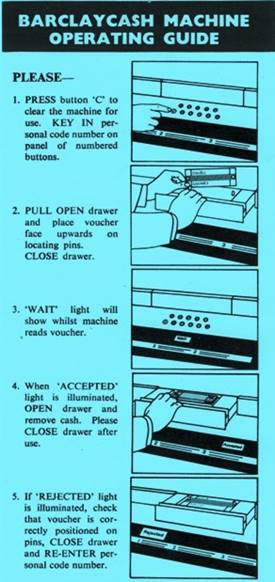
|
Barclays
makes the bold move of basing the use of its cash machines upon the
principle of the cheque. After all, customers are familiar with the idea of
exchanging a cheque for cash INSIDE the bank, so it follows that their
brain will not be too taxed by being asked to offer a similar voucher to a
machine OUTSIDE the branch, in order to receive a pre-approved amount of
money. As we can see in the example
above, special cheques worth £10 each are issued to “approved”
customers. The customer’s details
are coded into the special series of holes punched into each cheque, and
the corresponding personal code number issued to the customer allows the BARCLAYCASH machine to decide whether or not to make its drawer full of cash
available. Whilst this system does
seem a little complicated against the simplicity of the card and PIN we all
use today, it is nevertheless first in its field, and allows Barclays to
pull off, (and deservedly enjoy the limelight of) the World’s first cash
dispenser. By 1970, most Banks have
given in to pressure from the Trade Unions to end the six day week, and
when your smiling cashier starts to enjoy his or her new found freedom on a
Saturday, customers are still able to get their hands on cash. The rest is of course history - Saturday
closure lasts only about twelve years before Barclays are once again in the
habit of being first to throw open the doors to offer all the services that
BARCLAYCASH and
its offspring BARCLAYBANK,
cannot…

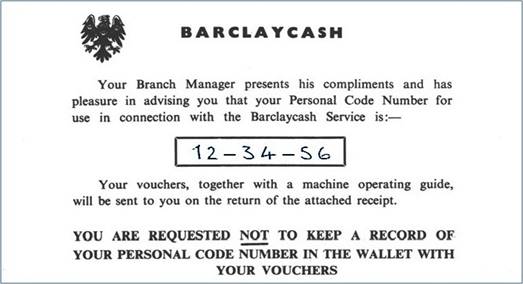
|
|

Special thanks to
Barclays Group Archives

|
|
![Design-Archives-Uni-Logo[1].jpg](Martins%20Auto%20Cashier_files/image053.jpg)
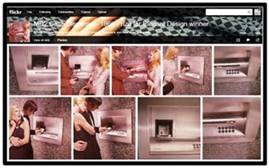 In response to our request for information and
images relating to the development of the CHUBB cash dispenser from the
original Martins design, our good friends at the University of
Brighton Design Archives dug deep and came up trumps with a wonderful set
of colour photographs taken in 1969 when the MD2 machine won the Prince
Philip Design Award. So pleased to
have found them, they decided to make them available to view in their
flickr® Photostream. They look as fresh today as when first taken and you
can see them in all their glory by clicking HERE. In response to our request for information and
images relating to the development of the CHUBB cash dispenser from the
original Martins design, our good friends at the University of
Brighton Design Archives dug deep and came up trumps with a wonderful set
of colour photographs taken in 1969 when the MD2 machine won the Prince
Philip Design Award. So pleased to
have found them, they decided to make them available to view in their
flickr® Photostream. They look as fresh today as when first taken and you
can see them in all their glory by clicking HERE.
|
|
|
|
|
|
|
|
|

![]()
![]()

![]()
![]()